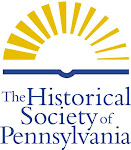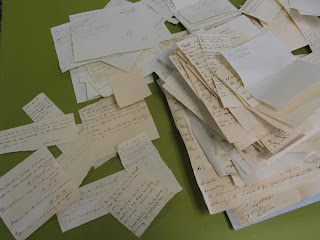
This survey shows William Jones' Meadow, which is part
of Greenwich Island (Surveyed by John Lukens, 1770)
This land passed down through the Johnson family from William Jones (a grazier in Kingsessing Township) to his daughters Mary (Morris, Pancoast) and Elizabeth (Garrett), then to Martha Morris, who married Joseph Johnson, a ship chandler. Johnson ran a booming business from his wharves in South Philadelphia during the late-18th century into the mid-19th century, and his descendants further developed the land as industrialization allowed for more manufactured goods to be moved from place to place. (Stay tuned for an upcoming post on the companies associated with David Sands Brown and the development of Gloucester City.)
As I was sorting through the various deeds that make up a large portion of the material in this series, I was trying to create a mental image of how all of these plots of land fit together. One day, I found a series of maps and surveys that helped me to create a picture of the area the deeds described, and I realized how vastly different the land is today. Aside from the Tinicum Wildlife Refuge, this land has given way to industrial development. Here are a few representations of William Jones' meadows as they were in the mid-1700s.


The first survey was done by John Lukens in 1768.
The second is the original survey done by Nicholas Scull in 1759.
Last night, as I was returning from the New England Archivists' Conference, my flight passed over the area that these surveys portray. I looked out the window and imagined what these waterways and marsh lands would look like without the grid of roads, parking lots, and buildings. I tried to conjure the land as the Swedes found it, before they drained marsh land for grazing. I perform these kind of thought experiments a lot as I sift through documents that shift my relationship to the land that I walk on every day, navigating the grid of Philadelphia's streets, or hanging in the air above this place that is at once so familiar, and so surprisingly new.

This lithographic plan shows the emergence of the South Philadelphia
that we know today. This "Plan of proposed Wharves & Docks with
Railroad Connections in the First Ward" was made for Titus S. Emery
by L.N. Rosenthal's Lithographic shop in 1867.







